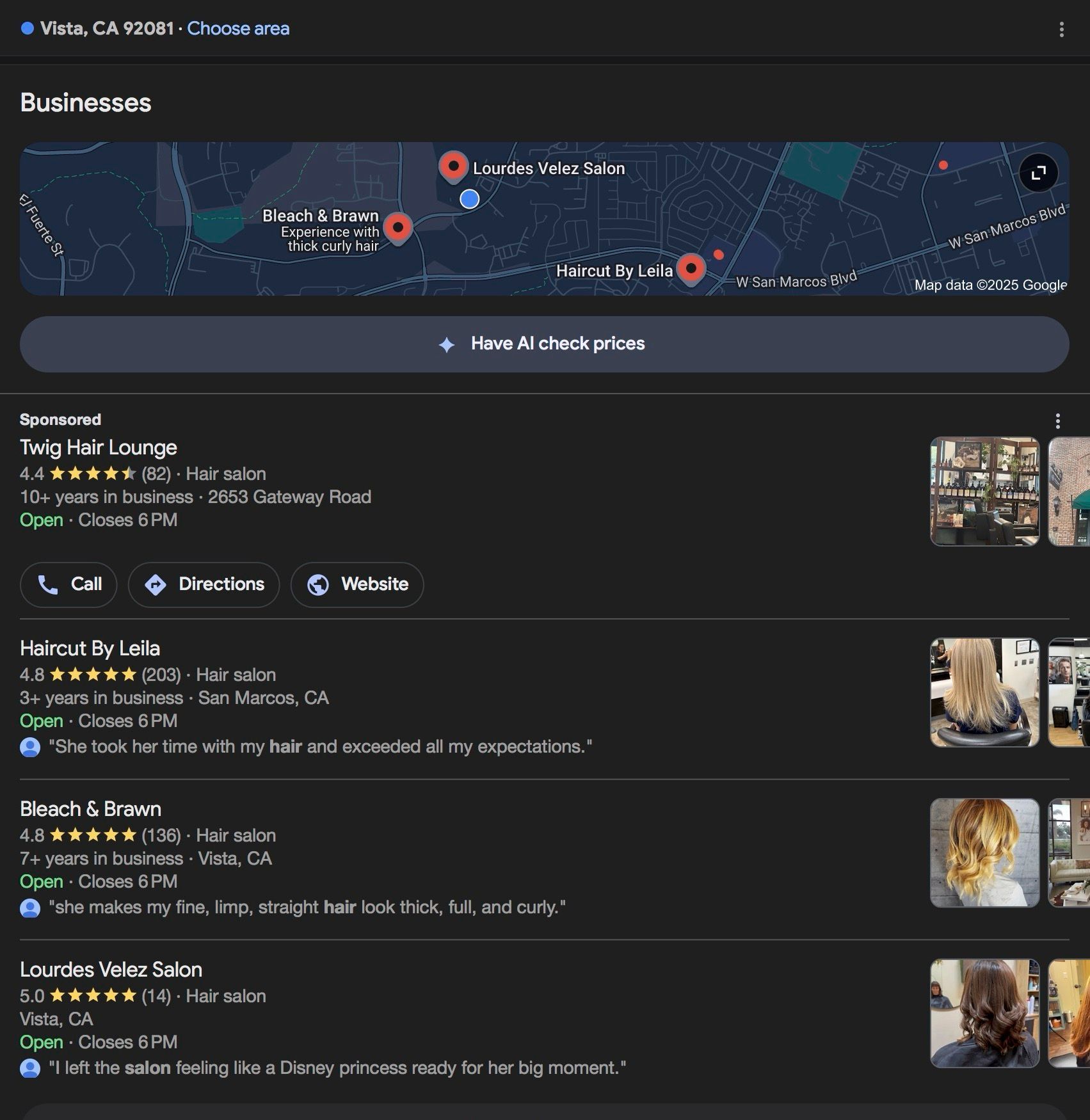Optimizing SEO for San Diego Restaurants: Attracting More Customers Online
Boosting Online Visibility and Foot Traffic: Mastering SEO for San Diego Restaurants

Optimizing SEO for San Diego Restaurants: Attracting More Customers Online
In today's digital age, having a strong online presence is crucial for the success of any business, and the restaurant industry is no exception. With the increasing competition in the San Diego dining scene, it is more important than ever for establishments to employ effective strategies to stand out and attract more customers. This is where Search Engine Optimization (SEO) comes into play.
SEO is the process of optimizing a website and its content to rank higher in search engine results pages (SERPs). By implementing SEO techniques tailored to the specific needs of the restaurant industry, establishments in San Diego can increase their visibility and reach a wider audience online. This, in turn, can lead to more website traffic, higher customer engagement, and ultimately, increased revenue.
Understanding SEO and Its Importance for Restaurants
What is SEO and Why is it Important?
SEO stands for Search Engine Optimization. It is the practice of optimizing a website to improve its visibility and ranking on search engine results pages. For restaurants, SEO is crucial as it helps attract more customers by increasing online visibility and driving organic traffic to their websites.
How SEO Impacts Restaurants
SEO has a significant impact on restaurants by improving their online presence, increasing website traffic, and attracting more potential customers. By optimizing their websites with relevant keywords, implementing local SEO strategies, and creating user-friendly content, restaurants can rank higher in search engine results and reach a wider audience.
Why Focus on SEO for Restaurants in San Diego
San Diego boasts a thriving dining scene with diverse culinary offerings. With numerous dining options available, restaurants in San Diego need to focus on SEO to stand out from the competition. By implementing effective SEO strategies, restaurants can increase their chances of being discovered by potential customers searching for local dining options.
San Diego Restaurant Industry Overview
San Diego Dining Scene
The dining scene in San Diego is diverse and dynamic, offering a wide range of culinary experiences to residents and visitors alike. From trendy gastropubs to upscale fine dining establishments, the city caters to various tastes and preferences. With such a competitive landscape, restaurants need to find ways to differentiate themselves and attract customers.
Unique Challenges for Restaurants in San Diego
While the San Diego dining scene presents exciting opportunities, it also comes with its share of challenges. One of the major challenges is the high level of competition. With numerous dining options available, restaurants need to find ways to stand out and capture the attention of potential customers. Additionally, the seasonal nature of tourism in San Diego can lead to fluctuations in customer demand, requiring restaurants to adapt their strategies accordingly.
Opportunities for Growth with SEO
Despite the challenges, San Diego restaurants have great opportunities for growth by leveraging SEO strategies. By optimizing their websites and online presence, restaurants can increase their visibility in search engine results and reach a broader audience. This can lead to more foot traffic, online reservations, and ultimately, higher revenue. With the right SEO approach, restaurants can tap into the potential of the San Diego market and attract more customers.
Local SEO and Its Significance for Restaurants
The Concept of Local SEO
Local SEO focuses on optimizing a website for local search queries. It involves targeting location-specific keywords, optimizing Google My Business listings, and obtaining positive customer reviews. For restaurants, local SEO is crucial as it helps them target potential customers in the local area and increase their visibility in local search results.
Why Local SEO is Crucial for Restaurants
Local SEO is crucial for restaurants as it allows them to connect with customers who are actively searching for dining options in their local area. By appearing in local search results and having an optimized Google My Business profile, restaurants can attract nearby customers and increase foot traffic to their establishments.
Leveraging Local SEO for Restaurants in San Diego
San Diego restaurants can leverage local SEO by including location-specific keywords in their website content, optimizing meta tags and descriptions, and ensuring accurate and up-to-date information on their Google My Business profiles. It is also important to encourage customers to leave positive reviews, as these can enhance a restaurant's local SEO efforts.
Google My Business and Its Role in Local SEO
Understanding Google My Business
Google My Business is a free tool provided by Google that allows businesses to create and manage their online presence on Google. It includes a business listing with important information such as contact details, location, opening hours, customer reviews, and photos. Google My Business plays a significant role in local SEO as it helps restaurants appear in local search results and provides valuable information to potential customers.
Why Google My Business is Important for Local SEO
Google My Business is important for local SEO as it is one of the key factors that influence a restaurant's visibility in local search results. By optimizing their Google My Business profile and ensuring accurate and up-to-date information, restaurants can improve their chances of appearing in the local pack and attracting local customers.
Optimizing Google My Business for Restaurants
Restaurants can optimize their Google My Business profiles by providing detailed and accurate information about their establishment, including opening hours, contact information, menus, and high-quality photos. Encouraging customers to leave positive reviews and responding to reviews promptly can also enhance a restaurant's online reputation and local SEO performance.
Keywords and SEO for Restaurants
Understanding SEO Keywords
Keywords are words or phrases that users enter into search engines when looking for specific information. In SEO, keywords play a crucial role in optimizing website content to rank higher in search engine results. For restaurants, keywords can include terms related to cuisine, location, menu items, and unique offerings.
Importance of Keywords for Restaurant SEO
Keywords are important for restaurant SEO as they help search engines understand the relevance of a website to specific search queries. By strategically incorporating relevant keywords into website content, meta tags, headings, and image alt tags, restaurants can improve their chances of ranking higher in search engine results and attracting relevant organic traffic.
Selecting and Using Keywords for Restaurants in San Diego
Restaurants in San Diego can select and use keywords by conducting keyword research specific to their target audience and local market. They can use tools like Google Keyword Planner or third-party keyword research tools to identify relevant keywords with a balance of search volume and competition. It is important to incorporate these keywords naturally into website content, including the homepage, menu pages, and blog posts.
Building a Mobile-Friendly Website
The Need for Mobile-Friendly Websites
In today's mobile-centric world, having a mobile-friendly website is essential for restaurants. With the majority of people using smartphones and tablets to browse the internet, a mobile-friendly website ensures a seamless and user-friendly experience for mobile users. Additionally, search engines prioritize mobile-friendly websites in their mobile search results.
Mobile SEO Best Practices
Mobile SEO best practices include optimizing website speed, ensuring responsive design, using readable font sizes, and optimizing images for mobile devices. Restaurants should also consider implementing features such as click-to-call buttons, online ordering options, and location-based services to enhance the mobile user experience.
Creating a Mobile-Friendly Website for Restaurants in San Diego
San Diego restaurants can create a mobile-friendly website by adopting responsive design principles, optimizing page load speed, and ensuring easy navigation on smaller screens. It is important to test the website on various mobile devices and regularly monitor and optimize its performance to provide the best mobile experience to users.
The Role of Social Media in Restaurant SEO
The Connection Between Social Media and SEO
Social media and SEO are interconnected as social signals can indirectly influence a website's search engine rankings. By actively engaging on social media platforms, sharing content, and encouraging social interactions, restaurants can increase brand visibility, generate backlinks, and drive more traffic to their websites.
Leveraging Social Media for SEO
Restaurants can leverage social media for SEO by optimizing their social media profiles with relevant keywords, sharing high-quality content that encourages engagement and sharing, and actively participating in conversations and discussions related to the restaurant industry. Social media platforms also provide an opportunity to promote events, special offers, and new menu items.
Social Media Strategies for Restaurants in San Diego
San Diego restaurants can implement social media strategies such as creating engaging content, running contests or giveaways, collaborating with influencers or local businesses, and responding promptly to customer inquiries and feedback. By maintaining an active and positive social media presence, restaurants can enhance their online reputation and increase their visibility in search engine results.
Using SEO to Improve Online Reviews and Ratings
The Impact of Online Reviews on SEO
Online reviews and ratings have a significant impact on a restaurant's online reputation and SEO. Positive reviews not only influence potential customers' decisions but also contribute to higher search engine rankings. Search engines consider reviews as an important factor in determining a website's authority and credibility.
Encouraging and Managing Online Reviews
Restaurants can encourage online reviews by providing exceptional customer experiences, offering incentives for reviews, and actively engaging with customers on review platforms. It is important to monitor and respond to reviews, both positive and negative, in a timely and professional manner to show customers and search engines that the restaurant values feedback and is committed to customer satisfaction.
Strategies for Improving Reviews and Ratings for Restaurants in San Diego
San Diego restaurants can improve their online reviews and ratings by consistently delivering excellent service, providing memorable dining experiences, and actively soliciting feedback from satisfied customers. Restaurants can also optimize their Google My Business profile, encourage customers to leave reviews, and share positive reviews on their website and social media platforms.
Creating SEO-Optimized Content for Restaurants
The Role of Content in SEO
Content plays a crucial role in SEO as it helps search engines understand the relevance and value of a website. For restaurants, creating high-quality, informative, and engaging content can attract organic traffic, establish the restaurant as an authority, and encourage backlinks from other reputable websites.
Types of SEO-Optimized Content for Restaurants
Restaurants can create SEO-optimized content such as blog posts, articles, recipe features, chef interviews, and user-generated content. Including relevant keywords, providing valuable information, and optimizing content with proper headings, meta tags, and internal links can help enhance the visibility and ranking of the restaurant's website.
Content Creation Strategies for Restaurants in San Diego
San Diego restaurants can implement content creation strategies such as showcasing local ingredients, highlighting regional specialties, sharing behind-the-scenes stories, and featuring local partnerships. Collaborating with local influencers or food bloggers can also help generate quality content and expand the restaurant's online reach.
The Impact of User Experience (UX) on SEO
Understanding the User Experience (UX)
User experience (UX) refers to the overall experience that a website visitor has while interacting with a website. It encompasses factors such as ease of navigation, website speed, mobile-friendliness, and the overall satisfaction of the user. Search engines prioritize websites that provide a positive user experience in their rankings.
UX and SEO: The Connection
UX and SEO are interconnected as search engines aim to deliver the best possible user experience to their users. Websites that prioritize user experience by providing fast-loading pages, intuitive navigation, and engaging content are more likely to rank higher in search engine results. Positive user experiences also lead to longer page visits, lower bounce rates, and increased chances of conversions.
Improving UX for Better SEO for Restaurants in San Diego
San Diego restaurants can improve the user experience of their websites by ensuring fast loading times, optimizing images and multimedia elements, optimizing navigation menus for easy access to important pages, and making the website mobile-friendly. Conducting user testing and gathering feedback can also provide insights for improving UX and enhancing SEO performance.
Conclusion
Summarizing the Importance of SEO for Restaurants in San Diego
In conclusion, SEO is a critical component of a comprehensive digital marketing strategy for restaurants in San Diego. By implementing effective SEO techniques tailored to the unique needs of the restaurant industry, establishments can increase their online visibility, attract more customers, and achieve business growth and success.
Encouragement for Restaurants in San Diego to Leverage SEO
We strongly encourage restaurants in San Diego to embrace SEO and take advantage of its benefits. With the right SEO strategies in place, restaurants can not only stand out from the competition but also connect with a larger audience, improve their online reputation, and drive more customers to their establishments.
Final Thoughts and Future Directions
As the restaurant industry continues to evolve, it is crucial for restaurants in San Diego to stay abreast of the latest SEO trends, adapt to changing customer behaviors, and continuously optimize their online presence. By staying proactive and forward-thinking, restaurants can future-proof their business and thrive in the dynamic digital landscape.





